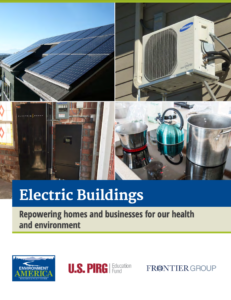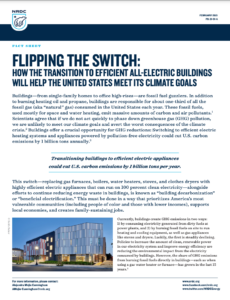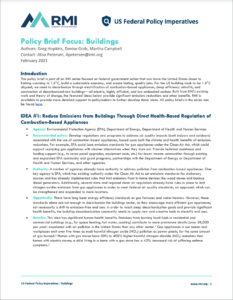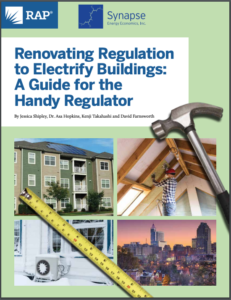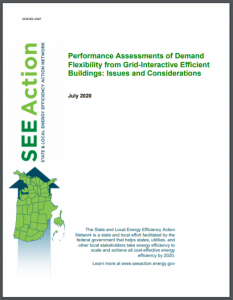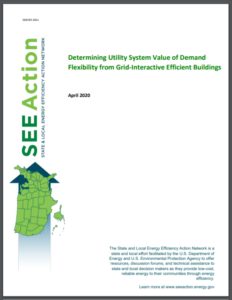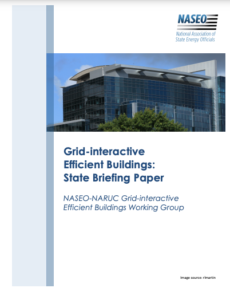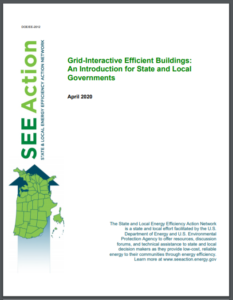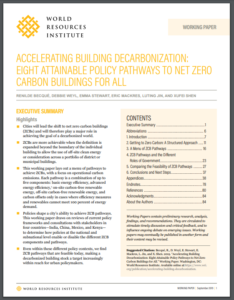The OurEnergyLibrary aggregates and indexes publicly available fact sheets, journal articles, reports, studies, and other publications on U.S. energy topics. It is updated every week to include the most recent energy resources from academia, government, industry, non-profits, think tanks, and trade associations. Suggest a resource by emailing us at info@ourenergypolicy.org.
Resource Library
71 to 80 of 342 item(s) were returned.
To prevent air and water pollution and avoid the worst impacts of global warming, America must move toward meeting our energy needs with 100% renewable energy. Getting there will require that we get the most out of every bit of energy we use – and that we stop burning fossil fuels in our homes and commercial buildings.
Wind and solar power are rapidly replacing dirty fossil fuels like coal as leading sources of our electricity. As our electricity grid becomes cleaner, replacing the direct burning of gas, heating oil and propane in our buildings with electricity will reduce pollution of …
View Full ResourceBuildings—from single-family homes to office high-rises—are fossil fuel guzzlers that emit massive amounts of carbon and air pollutants. Scientists agree that if we do not act quickly to phase down greenhouse gas pollution, we are unlikely to meet our climate goals and avert the worst consequences of the climate crisis. Replacing fossil fuel equipment with highly efficient electric appliances and running them in energy efficient homes with clean, renewable electricity are key and necessary parts of the strategy to fight the climate crisis.
In addition to burning heating oil and propane, buildings are currently responsible for about one-third of all …
View Full ResourceThis policy brief is part of an RMI series focused on federal government action that can move the United States closer to limiting warming to 1.5°C, build a sustainable economy, and create lasting, quality jobs. For the US building stock to be 1.5°C aligned, we need to decarbonize through electrification of combustion-based appliances, deep efficiency retrofits, and construction of decarbonized new buildings—all-electric, highly efficient, and low-embodied carbon. Built from RMI’s existing work and theory of change, the featured ideas below provide significant emissions reductions and other benefits. RMI is available to provide more detailed support to policymakers to further develop …
View Full ResourceNew technologies, such as air source heat pumps and smart thermostats, are changing the way we produce and use energy — making it cheaper and more efficient to electrify heat and hot water in buildings. As the power grid gets cleaner by adding more renewable energy, it will make home electricity use cleaner too. This reality presents an opportunity for buildings’ energy use to take advantage of the power grid’s flexibility. Home energy technologies can in effect turn a building into a thermal battery, precooling or preheating spaces and water supply, and can help shift electricity demand away from more …
View Full ResourceThis SEE Action Network report explains basic concepts and fundamental considerations for assessing the actual demand flexibility performance of buildings participating in demand flexibility programs and responding to time-varying retail rates. Demand flexibility is the capability of distributed energy resources (DERs) to adjust a building’s load profile across different timescales. Assessments determine the timing, location, quantity, and quality of grid services provided.
The results can be used for financial settlements and to improve performance of demand flexibility, support its consideration in resource potential studies and electricity system planning, and contribute to cost-effectiveness evaluations.
While practitioners and regulators regularly find opportunities …
View Full ResourceThe work described in this study was funded by the U.S. Department of Energy’s (DOE’s) Building Technologies Office, Office of Energy Efficiency and Renewable Energy, under Lawrence Berkeley National Laboratory Contract No. DE-AC02-05CH11231. This study was prepared under DOE’s authority to encourage and facilitate the exchange of information among State and local governments with respect to energy conservation and energy efficiency, and provide technical assistance on such matters. This study was specifically prepared for the use and dissemination of the State and Local Energy Efficiency (SEE) Action Network, a DOE program that DOE and the U.S. Environmental Protection Agency facilitate, …
View Full ResourceIn states across the nation, the electricity system is changing, presenting challenges and opportunities for the delivery of reliable, clean, and affordable power to America’s homes, businesses, and institutions. As variable renewable generation and distributed energy resources (DERs)—including energy efficiency, demand response (DR), onsite generation, energy storage, and electric vehicles (EVs)—grow, the management of electricity is becoming more complex.
Fortunately, advancing technologies open the prospect for more flexible management of building and facility energy loads to benefit occupants, owners, and the grid. Grid-interactive Efficient Buildings (GEBs) take advantage of these new capabilities to optimize energy management by using sensors, analytics, …
View Full ResourceThe work described in this study was funded by the U.S. Department of Energy’s (DOE’s) Building Technologies Office, Office of Energy Efficiency and Renewable Energy, under Lawrence Berkeley National Laboratory Contract No. DE-AC02-05CH11231. This study was prepared under DOE’s authority to encourage and facilitate the exchange of information among State and local governments with respect to energy conservation and energy efficiency, and provide technical assistance on such matters. This study was specifically prepared for the use and dissemination of the State and Local Energy Efficiency (SEE) Action Network, a DOE program that DOE and the U.S. Environmental Protection Agency facilitate, …
View Full ResourceThis report shows how improving the energy efficiency of Class B and C office buildings is doable with relatively simple, lower-cost measures that not only enhance building performance, but boost property values to make the buildings more competitive.
This research, generously supported with funding from the Building Owners and Managers Association and Yardi and prepared by ULI’s Greenprint Center for Building Performance and the Rocky Mountain Institute, explores the challenges and opportunities to achieve energy efficiency across Class B/C office portfolios. This market is a traditionally forgotten segment for energy efficiency and green leasing as information, resources, and funding constraints …
View Full ResourceBuildings that emit no greenhouse gas emissions during their operation are vital to meeting the SDGs and Paris Agreement targets. But in the past, zero carbon buildings have been assumed to be only attainable by technologically advanced or wealthy countries. New WRI research finds there are policy pathways to reach zero carbon buildings regardless of location or development status. The report identifies eight pathways countries can take to reach zero carbon buildings by reducing energy demand and cleaning energy supply.
-
Cities will lead the shift to net zero carbon buildings (ZCBs) and will therefore play a major role in achieving
